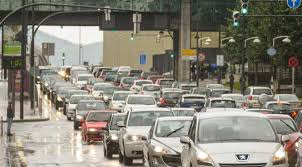Most of the population of Hego Euskal Herria breathes polluted air according to Ekologistak Martxan
- According to Ekologistak Martxan, a million and a half people in the CAV have breathed contaminated air in 2018: 70% of the population, in 47% of the territory. As far as Navarre is concerned, two-thirds of the territory is suffering from a high level of pollution.

Ekologistak Martxan has presented the Spanish State's Air Quality Report, which is prepared annually by the Environmental Action Group. Data from the 55 official pollution measurement stations in the CAV, as well as 12 in the Community of Navarra, have been analyzed, taking as a reference the pollution levels recommended by the World Health Organization.
In 2018, the pollution levels of particulate matter (PM10 and PM2.5) by nitrogen dioxide (NO2) and sulphur dioxide (SO2) have been reduced, according to the report. The main causes have been heavy rainfall and atmospheric instability, which have contributed to improved air quality. The fall in electricity production has also been affected. On the contrary, the use of fossil fuels has increased, especially in transport and industry.
Ozone pollution has also remained high. Tropospheric ozone is the pollutant with the greatest impact and its rates are maintained or increased. According to Ekologistak Martxan, the consequences of climate change are in the rise of average temperatures and heat waves.
Capital, roads and industry
The environmental group recalls that the level of ozone concentration in the air of the CAV is dangerous for both humans and nature in general. The main sources and generators of pollution are the three capitals of the CAV, the highways, the motorways and the industries of the region of Bajo Nervión, according to the report. Pollution generated in these areas extends to environments through tropospheric ozone.
Ekologistak Martxan criticizes the Basque Government for not approving the plans of the region of Nerbioi Behera and the Internal Basins: “An irresponsibility that endangers the health of one million people in these areas.” It has underlined the importance of reducing traffic in capitals by promoting public transport, cycling and mobility on foot. It has also considered it necessary to promote energy saving.
Regarding Navarre, in addition to the problem of urban centers, the environmental group has focused on a specific problem: In the context of the company Magnesitas de Navarra in Zubiri, last year the levels of SO2 recommended by the World Health Organization were exceeded 11 times. According to the report, Navarre has two main pollution axes: One in the Ebro Valley, by the influence of combined cycle thermal power plants (Castejón y Arrubalgo de La Rioja), as well as the Guardian Glass and Faurecia de Tudela and AP-15 and AP-68. The other, located in the north of the community, is among the factors that influence pollution with intense traffic around the Portland factory, Torraspapel, Volkswagen Pamplona and the City Headquarters, among others.
Kutsatzaile kimiko toxikoak hauteman dituzte Iratiko oihaneko liken eta goroldioetan. Ikerketan ondorioztatu dute kutsatzaile horietako batzuk inguruko hiriguneetatik iristen direla, beste batzuk nekazaritzan egiten diren erreketetatik, eta, azkenik, beste batzuk duela zenbait... [+]
Lurrak guri zuhaitzak eman, eta guk lurrari egurra. Egungo bizimoldea bideraezina dela ikusita, Suitzako Alderdi Berdearen gazte adarrak galdeketara deitu ditu herritarrak, “garapen” ekonomikoa planetaren mugen gainetik jarri ala ez erabakitzeko. Izan ere, mundu... [+]
Ur kontaminatua ur mineral eta ur natural gisa saltzen aritu dira urte luzeetan Nestlé eta Sources Alma multinazional frantsesak. Legez kanpoko filtrazioak, iturburuko ura txorrotakoarekin nahasi izana... kontsumitzaileen osagarria bigarren mailan jarri eta bere interes... [+]
Greenpeaceko kideak Dakota Acces oliobidearen aurka protesta egiteagatik auzipetu dituzte eta astelehenean aztertu du salaketa Dakotako auzitegiak. AEBko Greenpeacek gaiaren inguruan jasango duen bigarren epaiketa izango da, lehenengo kasua epaile federal batek bota zuen atzera... [+]


















.jpg)


